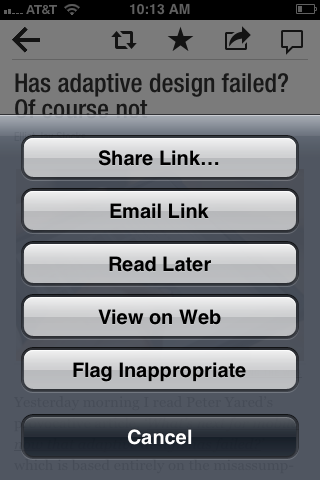by jydesign | Jul 6, 2016 | Blog
As of mid-March 2016, I’ve joined the UX Strategy and Design firm founded by my long-time colleague Theresa Neil. Time has been flying by and the projects, team and clients are wonderful.
I plan to post more about the work we are doing. In the meantime, you can find me collaborating (virtually and IRL) with a team of about 20 other experienced design pros, working on projects that require:
- User Research
- UX Strategy
- UI & Visual Design
- Prototypes & Demos
by jydesign | Jul 18, 2012 | Blog
Mobile smartphones and tablets have been on a meteoric rise since the iPhone initially shipped in 2007. However, there are conflicting trends that could stagnate growth in the U.S., if they are not adequately addressed in a user-centered way.
Carriers & Manufacturers Are Out of Sync Regarding Data Plans
‘I don’t give a f*&% how thin your phone is, I want unlimited data…’

“Gambling genie” by Lisa Brewster
When Horace Dediu kicked off mobilism 2012, he presented an impressive animated chart that illustrated the ascension of the iPhone relative to its competitors. People generally attribute this rapid success to the genius of the iPhone hardware feature set. However, one of the main “features” that secured its success, in my opinion, was that it originally shipped with a single unlimited data plan via AT&T. People were fed up with being nickled and dimed with fees for internet access, email, downloading music, transferring photos, backing up contacts etc. The content-liberated iPhone hardware, plus the simple unlimited data plan, sealed the deal for many and justified the relatively high cost.
Ever since the iPhone took off and tablets got into the game, AT&T (and eventually the other major carriers) have been trying to stuff that unlimited-data-Genie back in the bottle. With tiered data plans, shared data buckets, throttling and other tactics, the redefined “unlimited” is a shadow of it’s brash 2007 incarnation. I could be argued that the iPhone was a better value in its first year than it is today. (more…)
by jydesign | Jul 16, 2012 | Blog
 I’ve been meaning to mention this topic for a while now. Some recent headlines* have been just the kickstart I needed. The growing popularity of mobile devices has signaled a major change in the way many people interact with their computing devices. This can be seen in the trajectory that Apple has taken with iOS as it has scaled up from iPhone to iPad, as well as the other major OSes available to consumers. (more…)
I’ve been meaning to mention this topic for a while now. Some recent headlines* have been just the kickstart I needed. The growing popularity of mobile devices has signaled a major change in the way many people interact with their computing devices. This can be seen in the trajectory that Apple has taken with iOS as it has scaled up from iPhone to iPad, as well as the other major OSes available to consumers. (more…)
by jydesign | May 31, 2012 | Blog
Share buttons may irritate us at the moment, but they’ll continue to mature in the way they are implemented and they’ll eventually become obsolete due to device-level capabilities.
 Oliver Reichenstein of Information Architects recently wrote a thoughtful and provocative article titled “Sweep the Sleaze”. Despite the broad strokes and firm tone of his piece, I’m very pleased to see a well thought out challenge to the often mindless and trend-rabid implementation of social sharing buttons. I think it’s an important addition to the discussion around best practices for social media. His general thesis brings the dialogue back to where it should have been all along – How can we tactfully implement sharing as part of a user-centered design process?
Oliver Reichenstein of Information Architects recently wrote a thoughtful and provocative article titled “Sweep the Sleaze”. Despite the broad strokes and firm tone of his piece, I’m very pleased to see a well thought out challenge to the often mindless and trend-rabid implementation of social sharing buttons. I think it’s an important addition to the discussion around best practices for social media. His general thesis brings the dialogue back to where it should have been all along – How can we tactfully implement sharing as part of a user-centered design process?
As Reichenstein indicated, each social service button has its own unique UX and flow. They also have their own set of pros and cons as they relate to improving the engagement of a target audience. In addition, they also share some general attributes that can either work for or against you, in terms of interaction and site performance. For example, the article highlights the general implications when it comes to displaying the number of times something was shared. You generally either look like a loser with a low count, or an over-shared meme, except for that fleeting period of time when the count is neither too low or too high.
In order to do something that’s better and more intelligent, content designers have to stop thinking in terms of a “bank of buttons” model. They must start exploring the features and flow of each individual sharing button as it relates to the interaction narratives they desire for their users. (more…)

 I’ve been meaning to mention this topic for a while now. Some recent headlines* have been just the kickstart I needed. The growing popularity of mobile devices has signaled a major change in the way many people interact with their computing devices. This can be seen in the trajectory that Apple has taken with iOS as it has scaled up from iPhone to iPad, as well as the other major OSes available to consumers.
I’ve been meaning to mention this topic for a while now. Some recent headlines* have been just the kickstart I needed. The growing popularity of mobile devices has signaled a major change in the way many people interact with their computing devices. This can be seen in the trajectory that Apple has taken with iOS as it has scaled up from iPhone to iPad, as well as the other major OSes available to consumers.  Oliver Reichenstein of Information Architects recently wrote a thoughtful and provocative article titled “
Oliver Reichenstein of Information Architects recently wrote a thoughtful and provocative article titled “